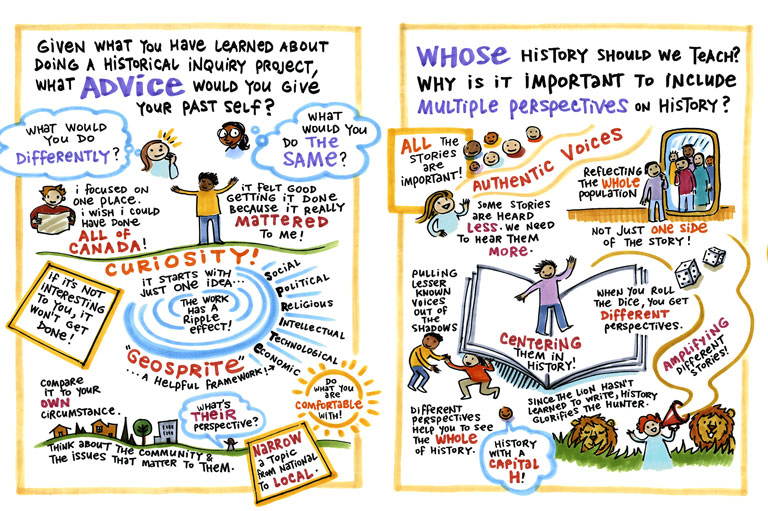Discover a wealth of interesting, entertaining and informative stories in each issue, delivered to you six times per year.
Growth of a Nation: Trading Cards
Grade Levels: 7/8, 9/10, 11/12
Subject Area: Social Studies, History, ELA, Civics, Creative Writing, Visual Arts
Lesson Overview
In this activity students create a package of 10 Canadian History Trading cards reflecting what they have learned and studied as their course progressed over the term.
Time Required
This activity should be introduced within the first two weeks of the course and is then ongoing throughout the term.
Historical Thinking Concept(s)
This lesson plan uses the following historical thinking concepts: establish historical significance, use primary source evidence, take historical perspectives.
Learning Outcomes
Student will:
- Select, examine, and critique information
- Appreciate the events and people that have shaped Canada
- Build analytical skills
- Reflect upon and apply course materials
Background Information
Each student will create a package of 10 Canadian History Trading Cards. These cards can be the size of a card in a regular deck of playing cards, or larger. Cards may even be made into an interesting shape (something that symbolizes Canada, perhaps a beaver, maple leaf, canoe, map). These cards will be a visual representation of the history of Canada's growth and maturity into the great nation it is today. The front of each card will include a visual of the topic, while the back will include a written explanation in paragraph form. The first paragraph will include factual details, while the second will provide the historical significance. Each card will be labelled with one or more of the Historical Thinking Concepts: Historical Significance, Primary Source Evidence, Continuity and Change, Cause and Consequence, Historical Perspectives, Ethical Dimensions. The ten cards will be packaged as if they were for sale in a souvenir shop in Canada.
The Lesson Activity
Activating:
- Distribute several baseball cards, trading cards, hockey cards, Pokémon cards etc.
- Ask: Do you own any? Collect cards?
- Ask: Why do you think trading cards remain popular? What makes them so?
- Explain that they will be creating 10 Canadian History Trading cards over the duration of the course.
Acquiring:
- Introduce the activity to the students by laying out the parameters:
- You must make 10 trading cards. Each may be the size of a card in a regular deck of cards.
- All 10 cards are to be packaged together (in a box of some sort) and must appear as they would if the product were for sale in a Souvenir Store.
- Cards #6 and #7 of the cards are to focus on positive aspects of Canada’s past.
- While cards #3 and #4 are to focus on the negative aspects of Canada’s past. (Event, person, invention, etc.)
- Select the ten subjects from five different times in Canadian history (2 each) from:
- The Laurier Era
- First World War
- Roaring Twenties/ Dirty Thirties
- Second World War
- Post war to the Present
- The front of the card is a visual to represent the topic you have chosen. No words are needed on the front of the card, be creative and use the entire area. To keep the look crisp, a border is a good idea.
- The back of the card will have the title of the event, person, object, that is the focus of the card, clearly printed in a visible fashion.
- The remainder of the back of the card is to be divided into two sections/paragraphs of printing. The first section gives a brief history or explanation of the event, person, invention etc. The second section should explain how Canada grew into the nation that it is today partly because of the experience (or person or invention) you are describing. This is the historical significance for Canada.
- An appropriate Historical Thinking Concept should be indicated on each card.
Applying:
- As the course progresses, frequently remind students to continue researching and creating their trading cards.
- Consider featuring a student’s completed trading card each week.
- At the end of the course, organize a gallery walk for students to view each other’s completed sets.
Materials/Resources
- Canadian History Trading Cards template
- Several baseball cards, trading cards, hockey cards, Pokémon cards etc.
- Card stock
- Textbook/class readings/Internet for research
Themes associated with this article
- French Canada
- Peace & Conflict
- Settlement & Immigration
- Women
- Arts, Sports & Culture
- Discover Your Community
- First Nations, Inuit & Metis
- Industry, Invention & Technology
- Ethnography
- Media & Communications
- War and the Canadian Experience
- National Politics
- Provincial/Territorial Politics
- Social Justice
- Treaty Knowledge
- Decolonization
- Exploration & Geography
- Canadian Identity
- Religion & Spirituality
- Canada and the Global Community





